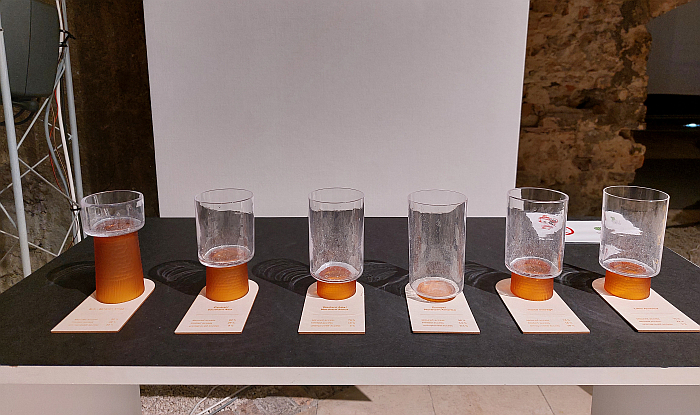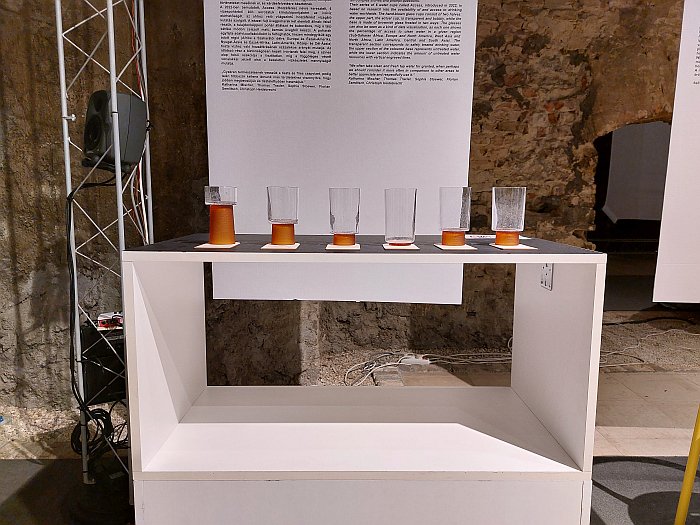
mischer'traxler a.k.a. Vienna based creatives Katharina Mischer and Thomas Traxler have, inarguably, been one of the more interesting and instructive design studios of the past decade and half. And that without ever achieving, without ever giving the impression of wanting to achieve, a wide public profile or a popular commercial acclaim. Always seem to have been perfectly happy getting on with doing their thing. Things. mischer'traxler do an awful lot of things.
Access is a very nice example of one of mischer'traxler's things, an effortlessly approachable example of one of mischer'traxler's things: a visualising of the contemporary world, of contemporary society, of contemporary realities via an unfamiliar medium that through being such allows, enables, fresh perspectives on both the subject at hand and on the myriad, oft unseen, relationships and associations betwixt the subject at hand and wider global society.
And do such in a manner that also helps expand definitions of function; the objects that mischer'traxler develop are invariably 'functional' as conventionally understood for the given genre, but that's not their primary raison d'etre. They are primarily otherly functional. While being conventionally functional.
Or put another way, Access presents itself as a set of six water glasses featuring a clear glass receptacle for holding water and a coloured base.
A set of six equally tall water glasses each featuring a differently sized clear glass receptacle for holding water and a differently sized coloured base.
Which of the six do you prefer most? One with a longer base or one capable of holding a larger volume of water?
Decisions, decisions!!!
A set of six equally tall water glasses each featuring a differently sized clear glass receptacle for holding water whose volume is defined by the percentage of the population of a specific global region with access to a safely managed drinking water supply i.e on demand, on site, and uncontaminated1, and a differently sized coloured base depicting both the percentage of the population of that region with access to a basic/limited drinking water supply — a safe source but not on site or demand — and also those with access to an unimproved — potentially contaminated — or to no managed drinking water supply.
Yes, it is a bit like a bar chart. Is a set of six water glasses.
And you'd probably ignore a bar chart of global managed drinking water supply statistics. You know you would, don't deny it. But you're looking at the water glasses trying to decide which of the six you prefer most
The one with a longest base is Sub-Saharan Africa where some 60% of the population don't have access to a safely managed drinking water supply. The one that can hold the most water is, you guessed it, Europe/North America, where some 96% do.
Which of the six do you prefer most?
You are allowed to say Europe/North America.
For although not about the glasses, is also about the glasses, about, for example, questions of our opinion on the volume of water a glass should hold, or about how we perceive and assess the proportions between base and body when considering which glass we prefer most, or are different forms of glass more or less appropriate for certain liquids than others. A water glass is a water glass, it'll work, we choose our water glasses on how they appeal to us formally, their tactility in the hand, the sensuous experience of drinking from them, the associations with drinks they bring forth, how we believe others will read them/us, the price, etc.
Which of the six do you prefer most? You are allowed to say Europe/North America.
In many regards Access is a brainstorming about drinking glass forms and drinking glass design, a brainstorming by way of trying to create as many different drinking glass forms as possible; a brainstorming undertaken via an essentially surrealist methodology.
A slightly, a very, macabre, methodology.
And primarily isn't about the glasses.
Something tending to be underscored by the choice of a slightly unhygienic looking brown hue for the base, a colour reminiscent of the silt and sludge and contamination that defines so much global drinking water. Less so in Europe/North America where the unappetising brown is almost invisible.
Primarily Access is about, is a project that forces consideration on and provides a basis for discussion on, for example, global drinking water inequality, and that on a planet getting hotter, wetter, less reliable, a planet of rising seas and sinking lakes, is that something we're prepared to accept or something we want to see change? And if you want it to change, what are you doing about it? Or is it not up to you? A global drinking water inequality that isn't and shouldn't just be seen in context of an international comparison, but also within the regions themselves; as discussed from Bauhaus and National Socialism at Klassik Stiftung Weimar, statistics provide an overview of a situation but don't go into personal details. Why do 4% of people in Europe and North America have no access to a safely managed drinking water supply? Who are the 30% in Sub-Saharan Africa who do?
Is a project that forces considerations on and provides a basis for discussion on our relationships with water, individually and collectivity, including demanding that you question how much drinking water was used in the production of the six glasses (including the development stage)? Is, was, that a sensible use of drinking water? How can glassmaking reduce its water footprint; a question analogous with that of reducing its gas footprint as (briefly) discussed with Cornelius Réer. Similarly one must question the drinking water consumption of contemporary industry and agriculture, the drinking water inherent in all our objects of daily use, one of the main themes of Water Pressure. Designing for the Future at the Museum für Kunst und Gewerbe, Hamburg where it was approached from a variety of perspectives, including brewing. Do we in those lands who have safely managed drinking water supply systems treat them with the respect we should? Do we in those lands who have safely managed drinking water supply systems take them for granted because they are there? What if we didn't? What if we did?
Question amplified by a comparison of Access with the project Narratives of Water by Vienna based Mexican nationals Ana Paulina Flores de la Torre and Juan Carlos Vertíz Márquez, a project presented just a few short steps from Access at Design Without Borders 2024, and which reflects on aspects of the contemporary global water crises in context of Austria and Mexico, including via a blue plastic barrel marked to indicate how much water the average Vienna resident uses in the course of an average day, and a similar blue plastic barrel cut in half to be used as shield during protests in Mexico about access to clean, safe water. Latin America, which we assume is the region in which Mexico stands, is the glass on the extreme right of the sequence as photographed: 75% secured access, 22% limited access, 3% unimproved access. Better than the global average, but, again, statistics aren't reflective of personal realities, just provide both an entry point for an overview of a situation and an aid to formulating questions that may be relevant going forward. As does Access.
And is also a project that forces considerations on and provides a basis for discussion on water glasses.
Which of the six do you prefer most?
We'd probably go for Western Asia/North Africa, third from the left, while very much wanting something like the European/North American glass, an object that doesn't appeal to us that much, to become a universal standard. No-one can be selfish about these things. We all need to look beyond our own position.
More details on mischer'traxler and Access can be found at https://mischertraxler.com
And more details on Design Without Borders, including information on the 2024 edition, can be found at https://design-without-borders.eu

1Information as supplied by Our World in Data. The defintions used can be found here.